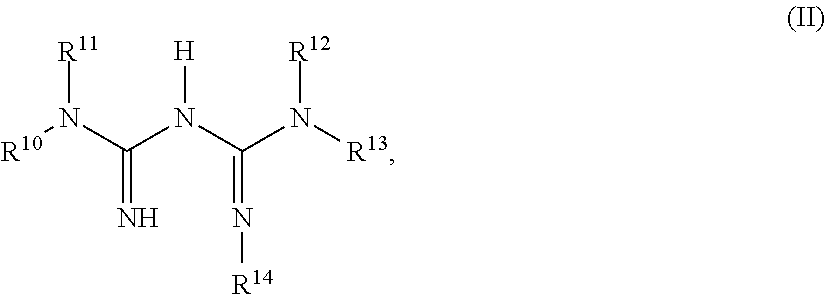Cleaning formulation for removing residues on surfaces
a technology of cleaning formulation and residues, applied in the field of new cleaning compositions, can solve the problems of ineffective removal of inorganic or organometallic residual materials by stripper solutions, difficult dissolution in stripper solutions, and ineffective removal of inorganic or organometallic residual materials by chemical methods used in wet stripping methods
- Summary
- Abstract
- Description
- Claims
- Application Information
AI Technical Summary
Benefits of technology
Problems solved by technology
Method used
Image
Examples
examples
[0129]The present disclosure is illustrated in more detail with reference to the following examples, which are for illustrative purposes and should not be construed as limiting the scope of the present disclosure. Any percentages listed are by weight (wt %) unless otherwise specified. Controlled stirring during testing was done with a 1 inch stirring bar at 300 rpm unless otherwise noted.
General Procedure 1
Formulation Blending
[0130]Samples of cleaning compositions were prepared by adding, while stirring, to the calculated amount of ultra-pure deionized water (DIW) the components of the cleaning formulation except for the metal ion free pH adjuster. After a uniform solution was achieved, the optional additives, if used, were added. Formulation of the composition was completed by the addition of the pH adjuster. The solution was allowed to equilibrate and the pH of the cleaning composition was taken, if desired.
[0131]The pH measurements, if desired, were taken at ambient temperature (...
formulation examples 18-38
[0156]To further elaborate on the compositions of this disclosure, additional cleaning compositions are described in Table 7. The “second chelant” in Table 7 refers to the polymeric biguanides having Structure (IV) (i.e., Polymers 1-8 below) or polymeric biguanides containing pendant biguanide groups (i.e., Polymers 9-12 below). Specifically, Polymers 1-8 are those of Structure (IV) in which n, R25 and R26 are defined below.
[0157]
Polymer #R25R26n1HC4-alkylene 102HC8-alkylene 153HC10-alkylene 204HC6-alkylene1005HC6-alkylene2006HC6-alkylene3007H—CH2CH2—O—CH2CH2— 208H—CH2CH2—CH(CO2H)—CH2CH2— 20;
Polymers 9-12 are those with pendant biguanide moieties and are listed below:
[0158]
9polyvinylbiguanide10polyallylbiguanide11poly(N-vinylbiguanide)12poly(allylbiguanide-co-allylamine)
[0159]
TABLE 7Polyamino-Form.HydroxylpolycarboxylicSecondCorr.OrganicEx.amineacidChelantInhib.SolventH2OFE-185.5%0.50% DTPAPolymer 10.25%EGBE 5%88.74%0.01%5MBTAFE-195.5%0.50% DTPAPolymer 20.25%EGBE 5%88.74%0.01%5MBTA...
PUM
| Property | Measurement | Unit |
|---|---|---|
| temperature | aaaaa | aaaaa |
| temperatures | aaaaa | aaaaa |
| temperature | aaaaa | aaaaa |
Abstract
Description
Claims
Application Information
 Login to View More
Login to View More - R&D
- Intellectual Property
- Life Sciences
- Materials
- Tech Scout
- Unparalleled Data Quality
- Higher Quality Content
- 60% Fewer Hallucinations
Browse by: Latest US Patents, China's latest patents, Technical Efficacy Thesaurus, Application Domain, Technology Topic, Popular Technical Reports.
© 2025 PatSnap. All rights reserved.Legal|Privacy policy|Modern Slavery Act Transparency Statement|Sitemap|About US| Contact US: help@patsnap.com



